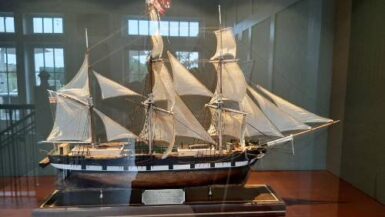
ARDMORE, PA – It’s going to be a tough week at the U.S. Open for everyone: players, officials, fans, broadcasters, writers, and locals alike. The choice of Merion – which is one of the most important golf courses in the world architecturally and historically – is proving uncommonly difficult logistically.
Merion is tiny, and the U.S. Open is enormous.
Traffic in Philly, already grueling, just went from “dull roar” to “New Years Eve Crazy” with the biggest party in the golf world taking over the city – an old city with many twists, turns, and cul-de-sacs. Moreover, there’s a run on rental cars, good hotel rooms, and patience as everyone has been warned to “plan on an extra half hour for everything.”
Guys, better make that a whole hour…
The venue site is an enormous maze. Entrances are not only hard to get to, but hard to find in the first place. Three parking lots have been shut down by the torrential downpours in the last five days, including the biggest, closest spectator lot.
Guys, better make that two hours…
Once you get inside, you can’t go anywhere except the shopping mall. The golf course and foot traffic paths are a confused jumble of dead-ends, circuitous routes, and long delays. It’s impossible to move around easily, spectate, or cover the tournament with up to the minute accuracy, (while out on the course at least), or keep from getting road rage every time you try to find anything other than “Spectator Square.”
It’s easy to find that though. All roads lead to the cash registers.
On that note, the merchandise tent alone is the size of a city block. I watched a female friend go in there “for five minutes” and she came out minutes later gasping for air and with a horrified expression on her face.
“I’m not doing that again,” she promised her amused boyfriend.
Even players, media, and officials are feeling a significant crunch. Players have to take shuttle to the practice area, they will start one day on 11, a brutal hole to open the day, and the “locker room” is a temporary structure.
It’s a nightmare for the media too. Not since Even Pebble Beach wasn’t this zany, (it was close, but there was at least twice as much room). The media tent is on the far side of the sixteenth fairway, so far out that we have to take a shuttle to the 18th green to interview the players. Just like at Pebble Beach, the fastest way from place to place sometimes is, according to U.S.G.A. officials, “to exit the event and then reenter by another nearby gate instead of walking all the way around.”
Worst of all, “Every hole is surrounded by stuff – tents or stands or towers – and you can’t see across the golf course like you’re supposed to. All you can see is a narrow tunnel of a hole or a window-pane like view of the green. The whole point was to have people see how special Merion is, and they can’t even see Merion at all,” fulminated one golf fan.
Finally, the weather is ghastly. That’s not anyone’s fault, they put every possible contingency in place, even hail storms, tornadoes, and earthquakes. But now it’s tough to get people off the golf course or at least afford them shelter. Five inches of rain over the weekend, more showers sporadically the first few days of this week, and now we’re told we’re getting a derecho tomorrow. A derecho, for those of you scoring at home is a tornado without the funnel cloud. Winds well over 100 miles an hour and hail the size of castanet knockers.
A tornado, by the way, is the one eventuality I am prepared for; I know exactly what to do in a tornado. You point at it, yell “Tornado!”, and run like hell.
Funnel cloud or no funnel could, the course is waterlogged and muddy to the point of saturation, dangerously close to the playable line. It’s no where near the mess Bathpage, (yes, Bathpage!), in 2009, but it just can’t take another weather body blow like it has for the past few weeks. Neither can we. Spending a week in Philadelphia cramped, wet, and with no sight lines is no one’s idea of fun.
So all this begs two question: 1) Was it really worth it to come here? and 2) Has the U.S. Open gotten too big?
We came here to make a point about golf course architecture: to prove that you don’t need 7,500 yards to defend a golf course, to show that smaller greens, side-hill lies, and intelligent design strategies are the best defense to a golf course, not length, water, and rough, and to show that the way forward to golf is to look to the design principles of the past. Yes, it’s worth it to try to come to Merion, because those points are important for the economic and cultural survival of golf. It’s critical to make the point about architecture.
“We knew that old-fashioned, Golden Age architecture and especially Merion could still hold up against modern technological advances in equipment and in the talent level of the modern professional golfer. Merion is still relevant and so is golden age architecture, and with firm and fast conditions, it would have acquitted itself nicely,” explained U.S.G.A. Architecture Archives committee member Tom Paul.
“It’s great that the U.S.G.A. came to a tiny place like this,” agreed ESPN’s Bob Harig. “We get to relive the history, and even if the winning score is low, who cares? It really doesn’t detract from the tournament at all.”
“There’s plenty off difficulty out there,” confirmed Luke Donald. “With the rough, bunkers, out-of-bounds, creeks, and side-hill lies, it would have proven harder than anyone expected and we would have seen that great design is timeless, even against modern equipment.”
Merion would have made all those points perfectly…had the weather cooperated.
And then the rain came and the whole plan went kablooie. Now instead of a lesson in design and strategies, we get interminable lectures on soils and drainage. That’s not the way we want to shine the light on architecture. We’ll bore everyone to death.
Apologies to all you supers, but soils ain’t sexy.
Has the open gotten too big?
Some think so, others don’t.
“The US Open is like ten circuses rolled into one,” explained Paul. “It’s tough for the U.S.G.A. to structure all these tents and stands and towers and move the people around on any site. Obviously this week was more of a challenge, but remember they only sold half the tickets they sold at Bethpage,” said Paul.
“And they put up half the corporate tents,” offered Harig.
That’s all true, but though they sold half the tickets of Bethpage, and put up half the tents of Bethpage, we still have as much or more congestion as at Bethpage. It’s impossible to move around, but that’s become a growing problem, not a new issue.
Take Torrey Pines in 2008. Mid-day on Friday that week I left my desk in the media tent and went out on to the course for a frozen coffee and to watch a little golf. Instead, I got mushed, crushed, jammed, crammed, tangled, mangled, beaned, and sardined by what could have passed for the second coming of every tribe of Visigoths that ever invaded Rome, Nome, or the River Somme. That’s what happened when, quite by accident, I walked headfirst into the heaving sea of humanity following the so-called “dream pairing” of Phil Mickelson, Tiger Woods, and their straight-man, Adam Scott, at that time still not a major winner, but still a major heart-throb to the “Look, he’s cute!” crowd.
I went to a golf match and, the next thing I knew, I was in the Torrey Pines version of a pinball machine, hockey game, biker rumble, and the Lower Oakland Roller Derby finals all rolled into one. That’s what I get for liking frappaccinos.
But Harig raises a great point, one that every broadcastrer, event planner, and fan should notice. To come to Merion and stage this tournament, even the U.S.G.A. is feeling a serious pinch. They will make 10,000,000 dollars U.S. less than they ordinarily would at a U.S. Open. Note that carefully: make 10 million less…not “lose 10 million.” (Don’t worry about the U.S.G.A., they can afford it.)
It’s eminently laudable of them to put the last dollar on the table aside. Stand up and cheer the altruism: It set a good precedent, and was classy too. Thanks for setting a great example, U.S.G.A., as usual. “For the good of the game” indeed.
Moreover, with a new venue each year, each open requires the U.S.G.A. to all but re-invent the wheel dealing with logistics.
“Each course represents new and different – and at often times difficult – set of logistics,” stated Global Golf Post editor-in-chief Jim Nugent. “They almost have to start from scratch every time, and they do their best to anticipate everything and accommodate…not please, but accommodate, everyone as best they can. This year, it’s like Baltusrol. We’re in a small neighborhood. This year was highly unusual circumstances, and
Merion is special, so we tolerated a lot to hopefully get a lot out of it.”
Let’s hope that’s true. It’s still early days, but the outlook is grim for this week. We have to do our best to make sure the fan experience doesn’t dwindle to the point of diminishing returns. The Masters puts fan experience first, and that’s why it’s the greatest spectator event in sports. At the U.S. Open, convenience and comfort come low so great golf can come first. Still, were not at the point where it’s unmanageable, but we’re getting too close. We need to keep a closer eye on exactly how much or little the fans enjoy their experience. Let’s never hope the best seat in the house is on your couch or in the media center lunch room.
Open venues are like dog breeds: there’s no perfect one, there’s always tradeoffs. The tradeoff here is a sublime golf course and an epic championship in terms of how interesting, tough, and historic the golf course is. But it’s going to be a long, wet, messy week.
As for the golf course itself though, the intention has not been lost on the players. Wen he turned from 18 to 1, Phil Mickelson saw U.S.G.A. executive director Mike Davis and told him, “This is my favorite Open setup ever.”




